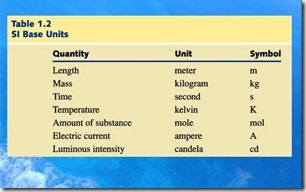International System of Units (S.I System)
This is a system of units that is internationally accepted for performing measurements. It’s the world modern form of metric system and is the most widely used measurement system.
Physical Quantities And S.I Unit
Before we dive into physical quantities and S.I Unit, let’s define some key terms.
- Dimension- Dimension refer to the characters of a derived quantity in relation to fundamental quantities, with respect for it’s numerical. Example; stress and force can be express in fundamental units, has oppose to strain, specific gravity and relative density.
- Physical quantity- A quantity that can be measured and given a magnitude. The mass of a body and also the time interval between events are example of physical quantities.
- Unit- a unit identify a specific physical quantity. Example; Second tell us the physical quantity we are dealing with is time. Also without unit it would be extremely difficult to evaluate data, because you would not know time from mass, etc.
Fundamental Quantities
Fundamental quantities are physical quantities that form the foundation of conducting measurements; they are independent of other quantities.
Fundamental (base) units are those units from which all other units are derived. There are seven fundamental quantities widely accepted, to which seven fundamental units are assign. The table below shows the fundamental quantities with their fundamental units.
|
Fundamental Quantity |
Unit |
Unit Symbol |
|
|
1. Mass |
Kilogram |
Kg |
|
|
2. Length |
Metre |
m |
|
|
3. Time |
Second |
s |
|
|
4. Current |
Ampere |
A |
|
|
5. Temperature |
Kelvin |
K |
|
|
6. Amount of Substance |
Mole |
mol |
|
|
7. Luminous intensity |
Candela |
cd |
Derived Quantities
Derived Quantities are quantities obtain by combining two or more fundamental quantities. Because of this their units are made up of two or more fundamental (base) units. Examples of derived quantities are velocity, acceleration, density, volume, frequency, force, impulse, stress, energy, and the list goes on.
Let’s examine velocity and see why it’s a derived quantity. Velocity is obtain from the following two fundamental quantities length and time. Velocity is obtained by dividing the length (refer to as distance) travelled by the time taken in seconds. Thus resulting in the formation of a derived quantity (velocity) and also its corresponding derived unit (metre per second). The equation below shows the process of obtaining velocity.
Types of Physical Quantities
|
Variable Quantities |
Constant Quantities |
|
1. Dimensional Variable- Area, stress, force, volume, energy, etc. Dimensional variables have no fix constant values, but they are express in fundamental unit. Remember every material occupy a different volume or cover a different area in most cases. |
1. Dimensional Constant- Gravity, etc. Gravity is a Dimensional Constant because its numerical value is fix and it is express in fundament unit. |
|
2. Dimensionless Variable- Strain, specific gravity, etc. Dimensionless variables have no fix constant values, but they cannot be express in fundamental unit. |
2. Dimensionless Constant- (…..,-2, -1, 0, 1, 2,…), e, π, etc. Dimensionless Constants have fix numerical values, but no units. |
Please note that etc means “others” and indicates that all the quantities are not listed


it’s amazing…. everything was explained in details and examples are given in every points which need clarification. I’m so happy to know this site. …. thanks and GOD bless you all.